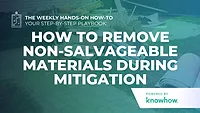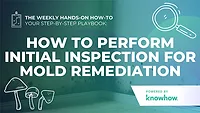Weekly Hands-on How-To powered by KnowHow
How to Complete Initial Fire Damage Mitigation Services

Image provided by KnowHow.
The flames are out, but the damage is just beginning. Long after a fire has been extinguished, soot, smoke, and lingering odors continue to cause destruction—staining materials, corroding surfaces, and embedding into every porous item in the building. Acting fast isn’t just recommended; it’s essential to minimizing further damage and setting the stage for a successful restoration.
Fire losses aren’t one-size-fits-all. Was water used to put out the fire? Did it burn out on its own? The answers determine whether you’re dealing with water damage, heavy soot contamination, or both. Knowing how to respond quickly and correctly can make all the difference in preserving salvageable materials and preventing secondary damage.
In this how-to, powered by KnowHow, we’ll walk you through the essential first steps of fire mitigation, from assessing the structure to deodorizing and removing unsalvageable materials. Here’s how to take control of the aftermath and restore order from chaos.
Step 1: Ensure the Structure is Safe to Enter
Before beginning any mitigation efforts, safety is the top priority. Fire damage can leave structures weakened, with compromised walls, ceilings, and flooring. Confirm with the fire department or safety personnel that the building is cleared for entry.
Once cleared, wear proper personal protective equipment (PPE) to safeguard against soot, debris, and airborne contaminants. Fire-damaged environments often contain lingering smoke particles and potential hazards, so respiratory protection, gloves, and protective clothing are essential.
Step 2: Remove Charred, Unsalvageable Materials
Eliminating heavily burned materials is one of the first steps to reducing smoke odor and cross-contamination. Charred debris can continue releasing odors and staining nearby salvageable materials if left in place.
Carefully remove irreparable drywall, flooring, furniture, and contents that cannot be restored. This not only improves air quality but also makes room for further cleaning and deodorization efforts.
Step 3: Identify the Type of Fire and Adjust Mitigation Efforts
Not all fire damage is the same. The mitigation approach depends on whether the fire was extinguished with water or burned out without intervention.
If water was used to put out the fire:
- This is considered a Category 3 (Cat-3) loss, meaning materials exposed to soot and water will likely need to be removed.
- Any standing water must be extracted immediately to prevent further contamination.
- Damaged non-porous materials should be discarded, as water and soot combined create a toxic, staining residue.
- Drying equipment will need to be deployed to stabilize the environment and prevent mold growth.
If the fire burned out on its own (no water):
- The focus will be on heavy cleaning rather than water extraction.
- Surfaces must be wiped down quickly before oxidation causes discoloration, particularly on non-porous items.
- Chemical sponges should be used to wipe walls and surfaces, lifting soot without spreading contamination.
Understanding the difference between wet and dry fire damage ensures that proper mitigation techniques are applied from the start.
Step 4: Vacuum Soot from Horizontal Surfaces
Before applying any cleaning solutions, vacuum all horizontal surfaces using a HEPA-filtered vacuum. This prevents fine soot particles from becoming airborne and settling on newly cleaned areas.
Pay extra attention to:
- Floors and countertops
- Window sills and ledges
- Shelves and furniture surfaces
Removing loose soot first will make the following cleaning steps more effective and prevent streaking.
Step 5: Perform Early Deodorization
Smoke odors can become deeply embedded in materials if left untreated. To contain and neutralize odors early, perform initial deodorization efforts before full-scale cleaning begins.
- Use water-based deodorants on affected flooring surfaces, applied with a compression sprayer.
- Deploy a fogger to counteract airborne odors—but first, notify any necessary authorities (fire department, police, property management) before use.
- Post warning signs in the area to alert workers and occupants to odor control procedures.
Early deodorization helps reduce lingering smoke odors and makes subsequent cleaning efforts more effective.
Step 6: Deodorize Surfaces and Contents
Selecting the right deodorizing agent is crucial for long-term odor control. Deodorants come in liquid, solid, and gel forms, with water-based, solvent-based, and heavy-duty dry solvent options. The choice depends on:
- The type of smoke residue (wet, dry, protein-based, etc.)
- The type of affected material (fabric, wood, plastic, metal)
Most deodorizing agents are highly concentrated and require proper dilution. Always follow manufacturer guidelines for mixing and application to ensure safe and effective use.
Key deodorization steps:
- Start in the room where the fire originated.
- Apply a water-based deodorant to the floor using a compression sprayer.
- Use a fogger to neutralize airborne odors.
This process ensures that odors are treated at their source rather than simply masked.
Step 7: Perform a Content Pack-Out
For extensive fire damage, performing a content pack-out may be necessary. Removing salvageable contents allows for:
- Thorough cleaning and deodorization in a controlled environment.
- Preventing further damage from soot and lingering odors.
- Efficient restoration and inventory tracking.
Once cleaned and restored, contents can be returned to the property in better condition than if left on-site during mitigation.
Stay in Control After the Fire with KnowHow
Initial fire damage mitigation is all about acting fast to prevent further damage, contain odors, and protect what’s salvageable. Every decision in those early hours matters — and having the right guidance can make all the difference.
That’s why top restoration companies use KnowHow. From step-by-step guidance on complex tasks to easy access to training materials and industry-standard SOP templates, KnowHow keeps your crew aligned and confident on every job. Whether it’s handling water-damaged materials, removing smoke residue, or managing content pack-outs, KnowHow ensures your team is always prepared.
Ready to turn chaos into control? Visit tryknowhow.com and see how KnowHow helps restoration pros get the job done right.
Looking for a reprint of this article?
From high-res PDFs to custom plaques, order your copy today!









